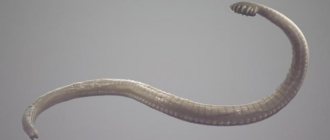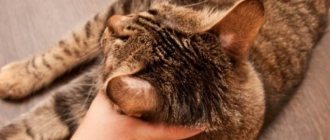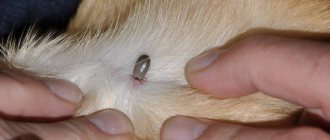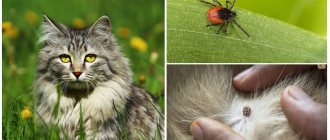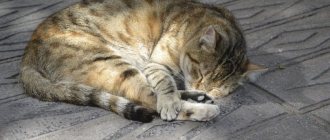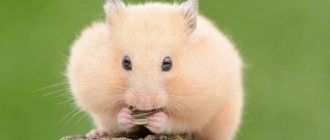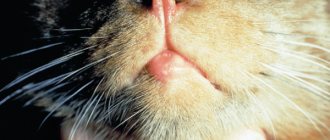Just like us humans, parrots are susceptible to diseases associated with various parasites, including mites.
And if we draw the analogy to the end, then, like in our case, diagnosis in this case is quite easy, but various consequences for the health of the bird can be very serious.
- Scabies mites in parrots
- Symptoms of mites in parrots
- Causes of mites in parrots
- Treatment of ticks in parrots
- Prevention of ticks in parrots
Sources of infection
It is impossible to rule out infection of a bird from a tick bite. Veterinarians identify the following sources of infection:
- Poor living conditions, non-compliance with the rules of basic hygiene and nutrition, lack of care on the part of the owner.
- You can buy an already infected pet. The probability increases if there are many birds in the cage and among them there are sick ones.
- Grain mixture of low quality or expired, damaged by fungus and mold.
- New plaid accessories that have not been heat treated. Toys that have been used or donated by the owners of another parrot pose a high risk.
- The presence in the house of bouquets or compositions of tree branches and shrubs that may contain parasites.
- Contact with an infected parrot during mating.
- Exceptional cases include the “transportation” of ticks on the soles of shoes.
Causes of parrot infection with scabies
Foot mange is rightfully considered one of the most common ailments among exotic poultry. This is due to the fact that there are many factors for the appearance of scabies mites in a pet. Let's take a closer look at what causes knemidocoptosis in parrots:
- Poorly processed food.
- Preliminary keeping of a pet with an infected bird. This factor plays a role if the parrot was purchased at a pet store.
- Dysfunction of the animal's immune system caused by stress or vitamin deficiency.
- Unsanitary conditions of detention. Lack of hygiene and infrequent cage cleaning double the chance of scabies infection.
- Sometimes owners want to pamper the bird with greenery or tree branches brought from the street. Remember, causative agents of knemidocoptic mange can also get to your pet along with them.
- If a bird is bought second-hand, then there is always the possibility that the parasite is already in its body, only in a latent form. It will definitely appear when the parrot becomes weak or becomes seriously ill.
- Recently purchased and insufficiently treated with antiseptic cage accessories.
- If your pet lives in an enclosure, wild birds can infect it with mites.
Symptoms of knemidocoptic mange in parrots can primarily be determined by their paws. During reproduction, the tick intensively forms tunnels in them. Therefore, the horny scales of the limbs are deformed, and the skin in the affected areas becomes lumpy. If the sore is discovered too late, this is fraught with inflammatory processes in the joints, flowing into necrotic changes in the phalanges of the bird’s fingers.
Knemidocoptosis develops slowly, obvious signs appear only after 3-4 months. The initial stage of the disease most often goes unnoticed by the owner. Therefore, in most cases, the bird comes to the veterinarian with an actively progressing pathology.
The later stages are characterized by a pathological transformation of the pet’s paws; it develops severe, incessant itching. The pet becomes restless and tries to independently scrape with its beak those places on its body that were damaged by the parasite. If treatment for knemidocoptosis is not started on time, this can lead to various complications and death of the bird.
The owner should pay attention to the following characteristic symptoms:
- the feathered skin becomes exposed, redness occurs in these places;
- in areas where mites accumulate the most, an itchy crust appears on the epidermis, which the bird scratches until it bleeds.
Limbs are not the only place where ticks can settle. If it affects a feathered area of the body, the parrot can tear out all the feathers from there to make it easier to relieve severe itching. Be careful, this behavior can become a bad habit.
The parrot's head, in particular the delicate skin on the eyelids and at the base of the beak, is particularly vulnerable to scabies mites. Signs of knemidocoptosis here appear as follows:
- the typical color of the beak and adjacent tissues loses its color and becomes duller;
- the parrot's beak becomes covered with small cracks;
- Rough spots with a large number of small holes appear on the surface of the beak.
According to statistics, young parrots most often suffer from scabies. If the owner detects the first signs of the disease, then an urgent need to go to the veterinary clinic. After the examination, the doctor will be able to make an accurate diagnosis and determine what therapeutic measures need to be taken to ensure that the bird recovers. Under no circumstances attempt treatment at home without first consulting a specialist.
Classification of parasites
The danger of a tick is that it exists for a long time without noticeable symptoms. A single focus of itching will not bother the bird much, but after viral bodies enter its blood and its immunity decreases, the parasite will begin to multiply.
Types of parasites:
Scabies One of the common types of parasites, it settles in the upper layers of the parrot's skin. The principle of infection is that the produced toxins are placed in the bite area and the bird is infected.
Feathered Has a small flattened body. It eats away at the skin and drinks the blood and lymph that appears on the surface of the epidermis after the bird scratches or gnaws itself in the hope of getting rid of the itch.
Tracheal Lives in the internal respiratory organs, where it makes a nest. After laying the larvae, the female crawls into the upper respiratory tract, and the male continues to infect the lungs of the bird.
Syringophilosis The parasite settles at the edge. The parasite feeds on lymph and gradually infects new feathers. Actively breeding.
Prevention measures
To prevent ticks from appearing on budgies, it is important to monitor the following points:
- provide proper, balanced nutrition;
- observe quarantine;
- regularly clean and disinfect the cage;
- When bringing new pebbles, twigs, leaves, scald them thoroughly with boiling water;
- feed the bird proven food;
- As soon as the first symptoms appear, begin treatment immediately.
Parrots often suffer from various parasites: feather mite, scabies mite. This pest is not dangerous to humans, but causes serious harm to birds.
It is not always possible to protect your pet from pests, but if an infection occurs, it is important to provide assistance to him without delay.
Keeping your pet's home clean
The tray is cleaned daily. Feeders and drinking bowls are washed with the same frequency. Leftover food and water are removed and replaced with fresh ones. It is necessary to clean not only the cage or enclosure, but also the space around it. With severe itching, the parrot itches intensely, skin flakes and particles of fluff and feathers, along with parasites, fly around and settle on the floor and objects. It is imperative to carry out wet cleaning.
Food processing
The food may contain helminth and tick eggs. This is especially true for food that healthy and sick birds eat together. Parasites are rarely found in ready-made commercial feeds.
Budgerigar food processing
Natural products must be thoroughly washed; if heat treatment is possible, then it is not neglected, with the exception of plant and other vitamin-rich foods, which lose beneficial substances when heated.
Disinfection of equipment and cages
Cleaning your parrot's cage should be done once a day. Preventive disinfection is carried out once a month. However, if a bird becomes infected with a mite, disinfection is necessary immediately after the first symptoms appear.
Before disinfection, it is necessary to thoroughly clean the cage, clearing it of excrement, food debris, feathers and other debris. (2-3 tablespoons per 1 liter of water) is used as a disinfectant The cage itself, tray, perches, rods and other equipment are thoroughly treated with the solution.
In addition, the purchased Desinsectal also has positive reviews. It contains substances that purposefully have a detrimental effect on ticks, both on adult individuals and on their eggs. The cell is treated with Disinsectal several times.
It is highly discouraged to use strong chemicals and chlorine-based solutions when disinfecting. In the future, this may negatively affect the health of the bird.
It is also useful to read: Growth on the beak of a budgerigar
Symptoms and stages of the disease
When bitten by a scabies mite, there are several stages of a pet’s disease:
- Initial. There is no way to identify the parasite. There are no symptoms during the incubation period of 120 days.
- Easy. Itching initially appears on the paws and wax, growths appear from scratching, peeling and flaking begin, the parrot often scratches the bite site.
- Average. The parasite begins to infect the beak, eyelids and cloaca. After a bite, the beak begins to deform, and the bird stops eating, and feathers may fall out.
- Heavy. Global baldness is observed, there are scabs on the bald spots, the beak is crooked and bent to the side, the joints on the paws are inflamed. The pet stops eating and drinking, does not respond to sounds and external stimuli. The body is completely infected within six months. If you are not careful, the tissue of the bird’s internal organs and limbs will begin to die, after which it will die.
When infected with feather mites, a parrot will experience severe itching. He feels uncomfortable, sleeps poorly and becomes restless, his appetite worsens or disappears. As the disease develops, wounds and ulcers on the body do not heal, and in a humid and warm environment the number of mites increases. The pet's immunity weakens, feathers fall out, and weight decreases. This type of parasite exhibits maximum activity in the summer. Identifying a tick is simple - you need to warm the bird under a lamp for five to ten minutes. Ticks are heat-loving and will crawl to the surface.
The tracheal mite moves along the lining of the throat, thus causing a sore throat and the bird begins to cough. Some ticks are removed with saliva during coughing, while others are removed along with droppings. The first sign is a change in voice timbre or its absence. As the disease develops, the bird will have a constant cough, sneezing, and whistling in the chest area. Later, the pet begins to breathe with its beak, constantly opening it. Wounds will increase on the internal organs of the animal and foci of inflammation will appear; baldness of the head may be observed - feathers will partially or completely fall out. The bird will begin to refuse food, shortness of breath and loss of consciousness will appear. The final and worst stage of the disease is paralysis and death. Infection and disease are often asymptomatic, which increases the danger of tracheal parasites. The diagnosis can only be made by a veterinarian after testing the mucous membrane and droppings.
Syringophilosis settles in the flight and tail feathers, and inflammation of the epidermis begins. The incubation period is 90 days. The bird is losing weight and is depressed. Spots appear on the feathers. They become dull and fall out. The disease occurs in young pets with weak immune systems.
Scabies mite
No less complex is knemidocoptic mange, a bird scabies caused by mites of the genus Knemidocoptes. The disease is characterized by insect damage to exposed areas of the body of birds (legs, cloaca area, base of the beak, eyelids, skin folds). Pests feed on fluff, skin secretions and dead particles of the epidermis, into which they penetrate by gnawing through labyrinths. Because of this, the horny scales that covered the legs rise, making the skin lumpy.
At the initial stage of the disease, the parrot is bothered by irritating itching. The bird constantly shifts from one leg to the other, trying to peck at the affected areas; can pluck its own feathers. After the horny scales fall off, the skin in these places becomes inflamed, ichor is secreted, and crusts begin to grow. Affected limbs become dirty gray in color (chalky feet).
If the condition is neglected, inflammation of the joints may develop, including necrosis of the phalanges of the fingers. At this stage of acariasis, the pet cannot stand on its feet. The same tuberous growths appear in the area of the eyelids and cere. The growths can change the size and shape of the beak, preventing the parrot from feeding normally. In places where insects are parasitized, accumulations of skin crusts are visible near the feather edges; focal loss of feathers is possible.
Treatment options
For the treatment of scabies mites, the most effective drug is birch tar. Apply a thin layer to the wounds. In advanced forms, doctors recommend lubricating the skin with Vaseline oil 2 times a day until recovery or Aversectin ointment for 5 days.
Important! Do not allow Aversectin ointment to come into contact with your eyes.
Cheaper medications are considered:
- Boric Vaseline - clogs the pores, leaves the parasite without oxygen, and it dies.
- Tar preparations.
One dose of the medicine is mixed with essential oil and spread on the epidermis. The tick will lack oxygen and die. On lubricated surfaces, the epidermis will become softer, scabs will be removed and new feathers will appear. Treatment should be carried out in courses - application of drugs once every 2 days for 3 weeks.
Not a single medicine affects the larvae, so the course is repeated once every 30 days after the parrot has recovered.
Treatment of feather mites is carried out with Arpalit, Celandine, Insectl. The release form of the drugs is repellent. You need to spray the medicine for 2 seconds from a distance of 20 cm very carefully to avoid poisoning your pet. Repeat the procedure after 7-8 days.
You can use traditional methods that are safe for birds:
- Rub ground wormwood powder into the feathers.
- Bathe your pet in chamomile decoction.
- Sprinkle feathers with sulfur powder.
Plant or sulfur powder can be rubbed in 3-4 times a day and repeated every week.
When a pet is infected with a tracheal mite, the following is prescribed:
- Ivermectin 0.2 mg/kg for 2-3 days, then a break. The drug kills only adult parasites. Apply to skin. 1 ml is diluted in a liter of water and the bird is fed for 4 days with a two-week interval.
- Permethrin and Imidacloprid are diluted 5:1. They eliminate parasites completely - from eggs to adults. Valid for 18 days. Carefully apply under the feather layer. They give expectorants to remove dead animals from the body.
Treatment for syringophilosis is carried out using Frontline or Otodectic with an active substance content of 0.1%. It is allowed to use an analogue of Ivermectin 0.1-0.12%. Apply to the withers and repeat after 3 weeks.
Feather mite in parrots
Feather mites are rare in parrots. More often they are diagnosed with the disease Syringophilia, caused by the mite; it prefers to settle in young feathers with a good blood supply. First, the tail feathers break off, then the feathers in the wings and on the back are destroyed.
The parasite is easy to detect if you examine the feathers under a microscope. You should start treating your parrot immediately as soon as ticks are detected. To do this, use a drug based on Ivermectin, lubricating the skin under the feathers on the back of the head.
